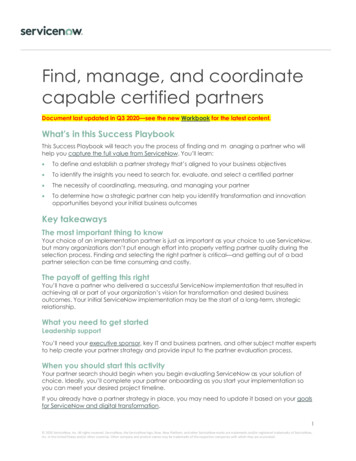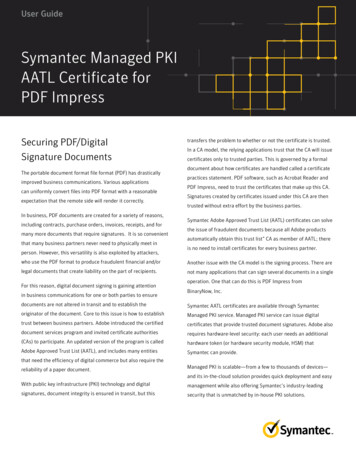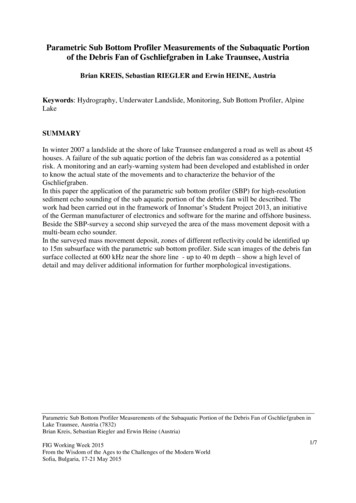
Transcription
Find, manage, and coordinatecapable certified partnersDocument last updated in Q3 2020—see the new Workbook for the latest content.What’s in this Success PlaybookThis Success Playbook will teach you the process of finding and m anaging a partner who willhelp you capture the full value from ServiceNow. You’ll learn: To define and establish a partner strategy that’s aligned to your business objectives To identify the insights you need to search for, evaluate, and select a certified partner The necessity of coordinating, measuring, and managing your partner To determine how a strategic partner can help you identify transformation and innovationopportunities beyond your initial business outcomesKey takeawaysThe most important thing to knowYour choice of an implementation partner is just as important as your choice to use ServiceNow,but many organizations don’t put enough effort into properly vetting partner quality during theselection process. Finding and selecting the right partner is critical—and getting out of a badpartner selection can be time consuming and costly.The payoff of getting this rightYou’ll have a partner who delivered a successful ServiceNow implementation that resulted inachieving all or part of your organization’s vision for transformation and desired businessoutcomes. Your initial ServiceNow implementation may be the start of a long-term, strategicrelationship.What you need to get startedLeadership supportYou’ll need your executive sponsor, key IT and business partners, and other subject matter expertsto help create your partner strategy and provide input to the partner evaluation process.When you should start this activityYour partner search should begin when you begin evaluating ServiceNow as your solution ofchoice. Ideally, you’ll complete your partner onboarding as you start your implementation soyou can meet your desired project timeline.If you already have a partner strategy in place, you may need to update it based on your goalsfor ServiceNow and digital transformation.1 2020 ServiceNow, Inc. All rights reserved. ServiceNow, the ServiceNow logo, Now, Now Platform, and other ServiceNow marks are trademarks and/or registered trademarks of ServiceNow,Inc. in the United States and/or other countries. Other company and product names may be trademarks of the respective companies with which they are associated.
Playbook overviewServiceNow recommends six steps to find, evaluate, select, onboard and manage a partnerthat will help you capture full value from ServiceNow.2 2020 ServiceNow, Inc. All rights reserved. ServiceNow, the ServiceNow logo, Now, Now Platform, and other ServiceNow marks are trademarks and/or registered trademarks of ServiceNow,Inc. in the United States and/or other countries. Other company and product names may be trademarks of the respective companies with which they are associated.
If you haven’t explicitly defined a partner strategy with your executive sponsor andstakeholders—one that incorporates your vision for digital transformation—start with Step 1.If you currently have a partner in place, you may want to start with Steps 5 and 6 to improvehow you’re managing your partner strategy.3 2020 ServiceNow, Inc. All rights reserved. ServiceNow, the ServiceNow logo, Now, Now Platform, and other ServiceNow marks are trademarks and/or registered trademarks of ServiceNow,Inc. in the United States and/or other countries. Other company and product names may be trademarks of the respective companies with which they are associated.
Step 1 – Define and establish a partner strategyKEY INSIGHTS Don’t just define partner requirements at a tactical level—a comprehensive partner strategyincludes requirements that reflect your transformation vision and desired business outcomes. Tap into the expertise of key stakeholders early. Include cross-functional expertise in yourpartner evaluation team. Ask for project management resources to steer the partner evaluation and selectionprocess.Define and establish your partner strategy early so you can make sure you’re aligned with yourlarger vision for transformation. When you prepare your requirements before implementation,you’ll be more effective in the partner evaluation and selection process—and your partner willbe able to deliver on your implementation needs.To define your partner strategy, complete these action steps:1. Define your partner requirements.The first step in any partner strategy is to define what you need from a partner – in terms ofthe skills and experience with the ServiceNow products you need, the support you expect,and how your partner will handle incidents and support.2. Define the metrics that include the partner in the contractual agreement.Establishing service level agreements (SLAs) early helps support the partner evaluationprocess and promotes accountability. Also establish goals for your partner to train yourinternal team and improve optimization.3. Build an evaluation team.Engage the right internal stakeholders early to support the decision-making process, gainsupport from business partners, and assist with the onboarding and management process.Customer insightsOur customers’ experience points to three insights you should keep in mind as you define yourstrategy.4 2020 ServiceNow, Inc. All rights reserved. ServiceNow, the ServiceNow logo, Now, Now Platform, and other ServiceNow marks are trademarks and/or registered trademarks of ServiceNow,Inc. in the United States and/or other countries. Other company and product names may be trademarks of the respective companies with which they are associated.
INSIGHT 1:Make sure your requirements reflect your vision and desired business outcomesYour organization may already have a partner strategy or possibly even a generic set of partnerrequirements. Or maybe you began defining requirements at a tactical level. If so, you’remissing the big picture.Your partner requirements should reflect your vision for transformation and your desired businessoutcomes. It’s not enough to have a requirement, for example, that your partner haveexperience with Incident Management. Instead, the requirement should reflect that the partnerhas demonstrated experience implementing Incident Management to improve incidentresolution speed, ideally in organizations of a similar scale.Best practice – Define what constitutes a successful partner fitBefore you start defining requirements at a tactical level, work with your executive sponsor todefine what constitutes a successful partner fit for your ServiceNow implementation.You should ask: What should we look for to determine if a partner is the right fit for our organizational culture(and any change we want to drive in our culture)? What kinds of partner experiences would give us confidence that a partner can deliver onour vision and business objectives? What red flags would signal to us that a partner is not a right fit for our needs?EXPERT TIPThink about a relationship with a partner that can broadly help you meet your digitaltransformation goals versus choosing one with a more product-centric view. Youcan also add niche or subcontracted partners to the mix to help supplement yourproject.Best practice – Document your ServiceNow licensing for clarity during partner evaluationTo provide clarity during the partner evaluation, and then during the implementation process,document in your partner strategy what ServiceNow product licensing your organizationpurchased.Having this insight will help: Provide an understanding of what ServiceNow product expertise your partner will need tohave for your project Give the partner critical insight into the scope of your implementation project, which theyneed to appropriately respond to your requests in the evaluation process–Example: If you purchased HR Service Delivery licenses and the partner lacks certifiedstaffing or has resource constraints for that product, they may explore a subcontractorrelationship to fill the gap or decline your project request. Having this information upfrontis important to making this decision.5 2020 ServiceNow, Inc. All rights reserved. ServiceNow, the ServiceNow logo, Now, Now Platform, and other ServiceNow marks are trademarks and/or registered trademarks of ServiceNow,Inc. in the United States and/or other countries. Other company and product names may be trademarks of the respective companies with which they are associated.
Avoid downstream confusion for your project team and partner on the products that you’llimplement–Example: If the partner doesn’t have clarity on the products your organizationpurchased, they could unknowingly create custom or scoped applications to addressbusiness needs.INSIGHT 2:Build the broader team as early as possibleYour choice of partner will affect the key IT and business stakeholders throughout yourorganization. If you neglect to include those stakeholders in defining a partner strategy, you’llmiss out on the opportunity to tap into their collective expertise to support a comprehensivedefinition of requirements, and to make smart evaluations of potential partners.Best practice – Determine potential stakeholder rolesAs you begin to define your strategy, approach potential stakeholders and collaborate withthem to determine what role they will play in partner selection and management. Ideally, workwith your executive sponsor to build and communicate a Responsible, Accountable, Consulted,and Informed (RACI) chart like the one in Figure 1. Using this RACI, stand up a partner evaluationteam. This team should: Be cross-functional to avoid bias or groupthink in the partner evaluation process. Contain the full range of expertise needed to support a comprehensive evaluation.Conduct a kickoff session with this team to establish a common understanding of the businesscase and partner requirements and to explain the team’s roles and responsibilities.Figure 1: partner evaluation team RACI6 2020 ServiceNow, Inc. All rights reserved. ServiceNow, the ServiceNow logo, Now, Now Platform, and other ServiceNow marks are trademarks and/or registered trademarks of ServiceNow,Inc. in the United States and/or other countries. Other company and product names may be trademarks of the respective companies with which they are associated.
EXPERT TIPConsult with your procurement team to learn about the internal resources you havewho can realistically evaluate vendors.INSIGHT 3:Enlist project management resourcesIt’s not likely that you’ll only be working on partner evaluation and management—most teamswear multiple hats and conduct several activities at the same time. But if you don’t allocatesufficient resources to carry out and manage your partner strategy, the strategy will be lesseffective.Best practice – Ask for a project managerUsing a project manager to manage your partner selection process can help keep the processon target to meet your implementation deadlines and allow you more time for strategic focusand better decision-making.What to do nextNow that you’ve laid the foundation for your partner strategy, you’re well prepared to developyour list of candidates to evaluate and then select the right one for your implementation.Be prepared to revisit how you’ve defined requirements and your evaluation team, especiallywhen: Your executive sponsor changes Your vision and business objectives change, or you expand ServiceNow capabilities You cannot identify a good list of partners You need to replace your existing partnerLike any good strategy, your partner strategy should be considered a living document—review itat least once or twice per year.7 2020 ServiceNow, Inc. All rights reserved. ServiceNow, the ServiceNow logo, Now, Now Platform, and other ServiceNow marks are trademarks and/or registered trademarks of ServiceNow,Inc. in the United States and/or other countries. Other company and product names may be trademarks of the respective companies with which they are associated.
Step 2 – Search for prospective partnersKEY INSIGHTS Don’t rely on a single or limited source for identifying prospective partners. Instead usemultiple channels to build a comprehensive, targeted list that matches your partner strategy.Once you’ve created a partner strategy and built a partner evaluation team, it’s time to searchfor prospective partners to evaluate. The ServiceNow ecosystem of partners is abundant,ranging from smaller boutique firms and specialized partners to larger global system integrators.Performing a comprehensive and targeted search for prospective partners is an essential start tosupporting a thorough evaluation and selection process.To do this, complete these action steps:1. Create qualification assessment criteria for prospective partners.Using the partner strategy you created in Step 1 as guidance, create qualificationassessment criteria that will give you direction as you research and identify prospectivepartners.2. Assemble a list of prospective partner candidates.Thoroughly research your vendors to assemble a list of prospective partners for evaluation.3. Select four to six prospective partners to target with requests for information.Distribute a request for information (RFI) to four to six prospective partners, then evaluatetheir responses with your partner evaluation team to create a short list of three to fourpartners for deeper evaluation.Customer insightOur customers recommend that you keep this insight in mind as you search for partners.INSIGHT:Use a comprehensive set of sourcesWhen searching, some organizations rely on a single (or limited) source for identifyingprospective partners. But singular or limited inputs aren’t enough to get you the right list. Everysource of data, even trusted word of mouth, contains some bias and needs to be balancedagainst other sources and perspectives.Best practice – Use multiple channels to research vendors and assemble a targeted list ofpotential partnersYou can build this list from the following channels within the ServiceNow ecosystem: Review the options on the ServiceNow Find A Partner website.8 2020 ServiceNow, Inc. All rights reserved. ServiceNow, the ServiceNow logo, Now, Now Platform, and other ServiceNow marks are trademarks and/or registered trademarks of ServiceNow,Inc. in the United States and/or other countries. Other company and product names may be trademarks of the respective companies with which they are associated.
–You’ll only find ServiceNow certified partners here, so if a vendor is not listed, they’re notcertified. Engage with your ServiceNow account executive for referrals. Attend ServiceNow events such as Knowledge, Now at Work, and SNUGs for opportunities toengage with partners directly and talk to other customers about their partner experiences. Talk with reference customers who are willing to share their experiences. Research partners on sites like Hoovers. Use groups like the ServiceNow Community to get customer references when needed.EXPERT TIPTypically, organizations will turn to a partner they’ve worked with in the past. Butpast experience alone is not a predictor of future performance, especially if yourbusiness needs have changed. Exercise due diligence and seek out additionalpartner candidates who can offer you a new perspective on your vision fortransformation.What to do nextWith your comprehensive search complete, your RFI process should have given you a short list ofthree to four partners to look into further so you can find the best match to deliver on your visionfor transformation.Your partner strategy may involve multiple partners based on the unique needs of yourServiceNow project. Think about your business objectives and roadmap when you search forpartners, because you may need to revisit options that could become a fit in the future. Forexample, you may find a partner that specializes in implementing IT Operations Managementbut who isn’t a broad fit for other parts of your ServiceNow roadmap.9 2020 ServiceNow, Inc. All rights reserved. ServiceNow, the ServiceNow logo, Now, Now Platform, and other ServiceNow marks are trademarks and/or registered trademarks of ServiceNow,Inc. in the United States and/or other countries. Other company and product names may be trademarks of the respective companies with which they are associated.
Step 3 – Evaluate prospective partnersKEY INSIGHTS Create a master list of questions to interview prospective partners and determine if you havea candidate that matches your partner strategy. Use anecdotal data from qualitative as well as quantitative measurements whendetermining a partner’s cultural fit and ability to address your business needs. Identify signals from partner stories that will help provide evidence of a potentially strong,collaborative relationship.With your short list of prospective partners, it’s time for a deeper evaluation. Your choice of animplementation partner is just as important as your choice to use ServiceNow, which means thatyou need to put in the right amount of effort into properly vetting partner quality during theselection process.It’s critical that you perform a thorough evaluation of your prospective partners before youmake your selection. Backing out of a bad partner selection is both time consuming and costly.To perform a targeted search for prospective partners, complete these action steps:1. Notify partners through the RFI evaluation that they’ve been selected for the next stage of theevaluation process.The next stage of the evaluation includes writing a request for proposal (RFP) and sending itto your short list of prospective partners. When you write the RFP, incorporate requirementsfrom your partner strategy and collaborate with your partner evaluation and procurementteams for guidance. Using an RFP process allows prospective partners to provide a deeperlevel of detail about their capabilities and customer references than an RFI. An RFP helpsyour organization make more insightful decisions to narrow down the prospective partner listbefore selection.2. Narrow down and evaluate the remaining partner candidates.Evaluate your RFP responses using a scorecard or evaluation criteria, and then contact theprospective partners’ customer references. Based on this, identify two to three partnercandidates for final evaluation. Finally, review the final two to three candidates, alsoreviewing the statements of work (SOWs) and pricing. This should give your team the depth itneeds to make a selection.10 2020 ServiceNow, Inc. All rights reserved. ServiceNow, the ServiceNow logo, Now, Now Platform, and other ServiceNow marks are trademarks and/or registered trademarks of ServiceNow,Inc. in the United States and/or other countries. Other company and product names may be trademarks of the respective companies with which they are associated.
Customer insightsOur customers say to keep these three insights in mind as you evaluate partners.INSIGHT 1:Create a comprehensive list of questions to elicit your partner’s perspectiveThe questions you ask your partner candidates shouldn’t be pro forma or generic, or limited tothe technical details of implementation. You should look at the questions you ask as your bestopportunity to gain insight into your partner’s perspective, both on how to get value fromServiceNow and capture business value from digital transformation. Always err on the side ofhaving a more thorough, comprehensive set of questions to get this perspective.Best practice – Create a master list of questions for partners to answerTo ensure a thorough evaluation of partners, create a master list of questions for your partners toanswer. Use your RFP responses to score their responses. If you’ve completed otherengagements with potential partners, like “partner evaluation days,” use that information aswell.Here are examples of common questions to ask partners, but you’ll need to tailor them based onyour specific preferences and the products you plan to implement.System implementation basics: What services do you offer (training, support, outsourcing, etc.)? What ServiceNow products (ITSM, HR, CSM, SAM, etc.) is your organization’s staff certified in? What percentage of staff are ServiceNow certified? What’s the average tenure of the team working with ServiceNow products? What are your approaches to engagement (complete drop-in package, some “canned”and some custom, all custom)? What’s your SDLC methodology (Agile, Waterfall)? What type of support model do you offer (email, phone, portal, chat)? Where is your staff located (locally, offshore)? Do you follow the recommended Now Value methodology?Digital transformation experience: What’s your experience with moving organizations to the cloud? What’s your experience with implementing ServiceNow mobile-enabled products? Can you provide examples of manual business processes you automated with ServiceNowworkflows for your customers? (Ask these for the applicable product capabilities you plan toimplement on your roadmap, like employee onboarding for HR) Can you provide examples of when you helped transform an organization’s employeeand/or customer experience?11 2020 ServiceNow, Inc. All rights reserved. ServiceNow, the ServiceNow logo, Now, Now Platform, and other ServiceNow marks are trademarks and/or registered trademarks of ServiceNow,Inc. in the United States and/or other countries. Other company and product names may be trademarks of the respective companies with which they are associated.
What’s your experience implementing innovative ServiceNow functionality, like agentintelligence? Can you provide case studies and references of customers you helped achieve digitaltransformation goals with ServiceNow?EXPERT TIPIf you don’t have any internal resources with ServiceNow experience to help youbuild your evaluation assessment, consider retaining an expert as advisor. To find anadvisor, use the ServiceNow ecosystem mentioned in Step 2.You’ll find additional information about certified partners on the ServiceNow Find A Partnerwebsite, including: Product implementation expertise – This shows the verified products the partner hasimplemented, such as Performance Analytics, Service Portal, etc. Number of certified professionals by product – This includes the type of certification (e.g.,Certified Implementation Specialist, Certified Application Developer, etc.), the productfocus, and the number of certified staff by certification type. Customer satisfaction rating – The ServiceNow Partner Program requires implementationpartners to register their services engagement projects. Upon project completion,ServiceNow conducts customer surveys on behalf of partners with mutual customers tomeasure success and gather feedback, which is used to continually improve partnerperformance. Each partner on the Find A Partner website displays a showcase of a rolling12-month average score of survey results. Results are refreshed monthly, and eligible partnersmust maintain a CSAT rating of 8.5 or above from a minimum of 6 respondents. The CSATscale ranges from 0–10 with 10 being the highest possible score. Each partner’s CSAT rating isequal to a rolling 12-month average score of customer responses received across allcompleted engagements. Country and region coverage – This lists each region and country the partner does businessin. Certification status – The partner’s certification status is either Registered, Specialist, Premier,or Elite, and they achieve it through a strict set of qualifications that ServiceNow frequentlyreassesses, such as the number of ServiceNow certified staff they have, the number ofregistered implementations they have completed, and their customer satisfaction surveyscores.EXPERT TIPHeavily consider the ServiceNow products your partner is certified on andexperienced with during your evaluation process. Selecting a partner with deepexperience in the products you plan to implement, that also has certified staff onthose products, will make your implementation infinitely more successful.12 2020 ServiceNow, Inc. All rights reserved. ServiceNow, the ServiceNow logo, Now, Now Platform, and other ServiceNow marks are trademarks and/or registered trademarks of ServiceNow,Inc. in the United States and/or other countries. Other company and product names may be trademarks of the respective companies with which they are associated.
Lastly, ask the partner to provide you resumes/CVs of the staff who will work on your project. Thiswill give you an opportunity to validate the level of ServiceNow product expertise, insight intocertifications, and location of the staff, which can factor into your decision-making preferences.Location can be a key factor because some organizations want their partner staff to be local forface-to-face access or because having a local team reduces travel costs when onsiteengagement is needed. Other organizations don’t have concerns with virtual or offshore partnersupport. When the partner uses offshore staff, it can also be a cost reducer for your project.With your agreement, the partner could also supplement your project with subcontractors oradditional niche partners. Make sure to get the resumes or CVs for those staff as well. In the end,getting access to resumes will help you determine if you are getting the ”A team” based on yourproject’s requirements.INSIGHT 2:Balance data with stories in your evaluation processSome organizations tend to overemphasize partner cost in the evaluation process, relative to thevalue a partner can bring to the table. Evaluating primarily on costs versus the benefits partnerscan provide may leave you with a partner that does the bare minimum to complete yourproject, impacting your ability to achieve your desired business outcomes.In an attempt to be as objective as possible, many evaluation processes will place a heavyweight on data: cost data, a partner’s volume of customer references, average time-toimplement, and so forth. While this data is certainly important, it can’t, by itself, provide anunderstanding of more subjective factors that determine if a partner is an optimal fit for yourorganization. The story told by data needs to be balanced with qualitative stories or anecdotesthat indicate whether your partner is a right fit from a cultural or other perspective.Best practice – Ask your partner to share anecdotes or case studiesThese anecdotes or case studies can help you determine if the partner is a cultural fit for yourorganization and can meet your business needs. Here are a few examples: How the partner helped a similar organization (ideally, of the same industry and size)achieve its transformation vision Success stories about realizing business objectives and adoption through implementationefforts, ideally with the same ServiceNow products that you need them to implement for you Case studies on how the partner has built solid relationships with their customers by goingabove and beyond the call of duty Case studies that reflect how the partner has handled challenging situations, roadblocks, ororganizational change management13 2020 ServiceNow, Inc. All rights reserved. ServiceNow, the ServiceNow logo, Now, Now Platform, and other ServiceNow marks are trademarks and/or registered trademarks of ServiceNow,Inc. in the United States and/or other countries. Other company and product names may be trademarks of the respective companies with which they are associated.
EXPERT TIPWhen you select a partner based principally on cost, you can end up with a partnerthat doesn’t have the experience or incentives to design for your future—whichmeans that you could ultimately pay more due to rework.INSIGHT 3:Vet partner stories with the executive sponsor and partner evaluation teamMany organizations will use a scorecard to evaluate prospective partners and make selectiondecisions. But when you over rely on your scorecard, you end up ignoring more qualitativefactors—and that can leave you with an incomplete picture of what a partner can offer.While it can be relatively easy to capture objective data through a scorecarding process, it canbe harder to evaluate the subjective data you’ve received from your candidates’ case studiesand anecdotes. So, you need to make sure you have an explicit, shared understanding of boththe business need and the characteristics that constitute a good cultural fit for your organization.Best practice – Find the story characteristics that fit your culture, business need, andtransformation visionVet partner stories with your executive sponsor and senior stakeholders (from your partnerevaluation team) to understand which story characteristics fit with your organization’s culture,business need, and vision for transformation. Partner stories should contain signs or signals thatwill point to a clear understanding of your needs and the potential for a strong, collaborativerelationship. To identify important signals from partner stories, ask these questions:Do the partner stories Reflect active listening and the ability to understand problems before identifying solutions? Indicate the value that partner staff place on strong relationships? Reflect a focus on getting the job done or on realizing business outcomes? Show an understanding of our transformation vision and desired business outcomes? Provide tangible evidence of experience with companies in my industry? Reflect commitment in the success of my organization? Reflect shared beliefs and values?What to do nextWhen you evaluate your partners comprehensively, considering both quantitative andqualitative factors, you can make a clearer and more confident decision. Get ready tonegotiate the final terms and contract, then onboard your partner to promote an effective startto your ServiceNow project.14 2020 ServiceNow, Inc. All rights reserved. ServiceNow, the ServiceNow logo, Now, Now Platform, and other ServiceNow marks are trademarks and/or registered trademarks of ServiceNow,Inc. in the United States and/or other countries. Other company and product n
This Success Playbook will teach you the process of finding and m anaging a partner who will help you . . Think about a relationship with a partner that can broadly help you meet your digital transformation goals versus choosing one with a more product-centric view. You can also a









